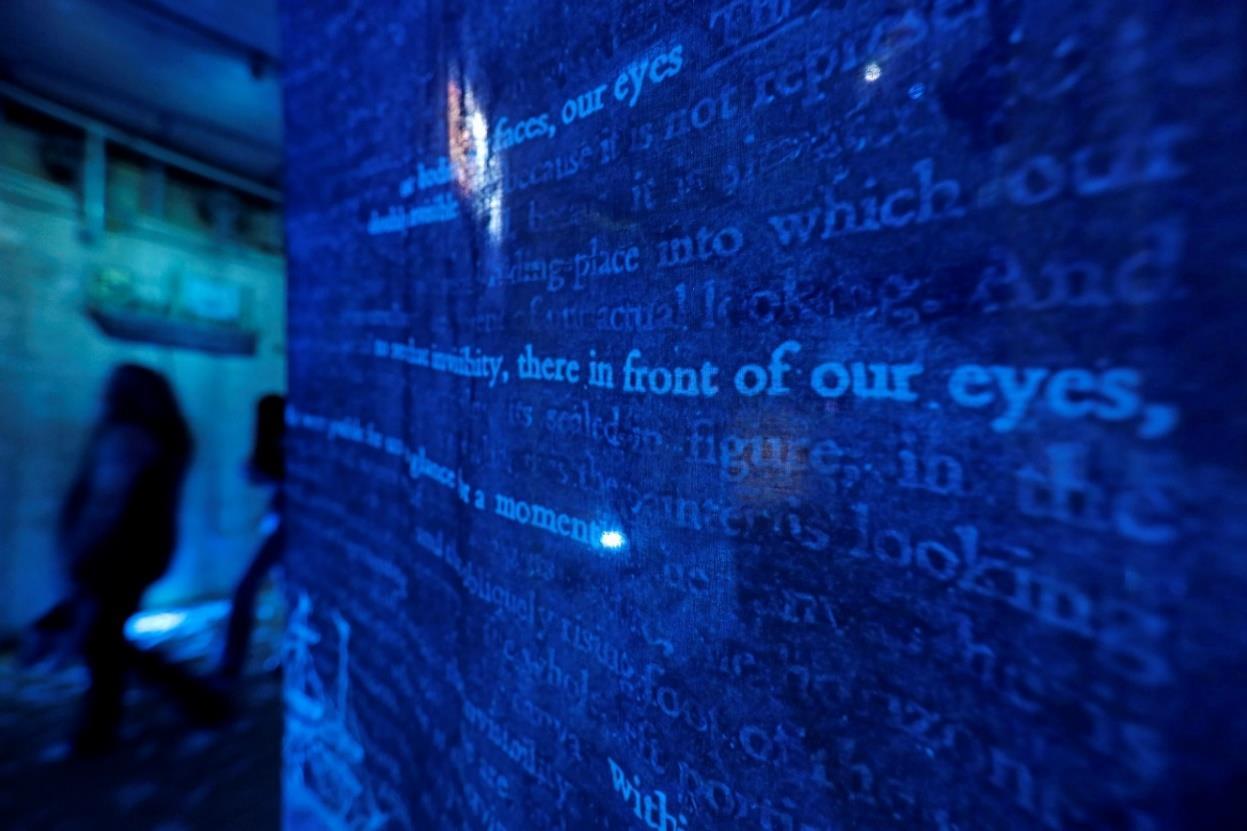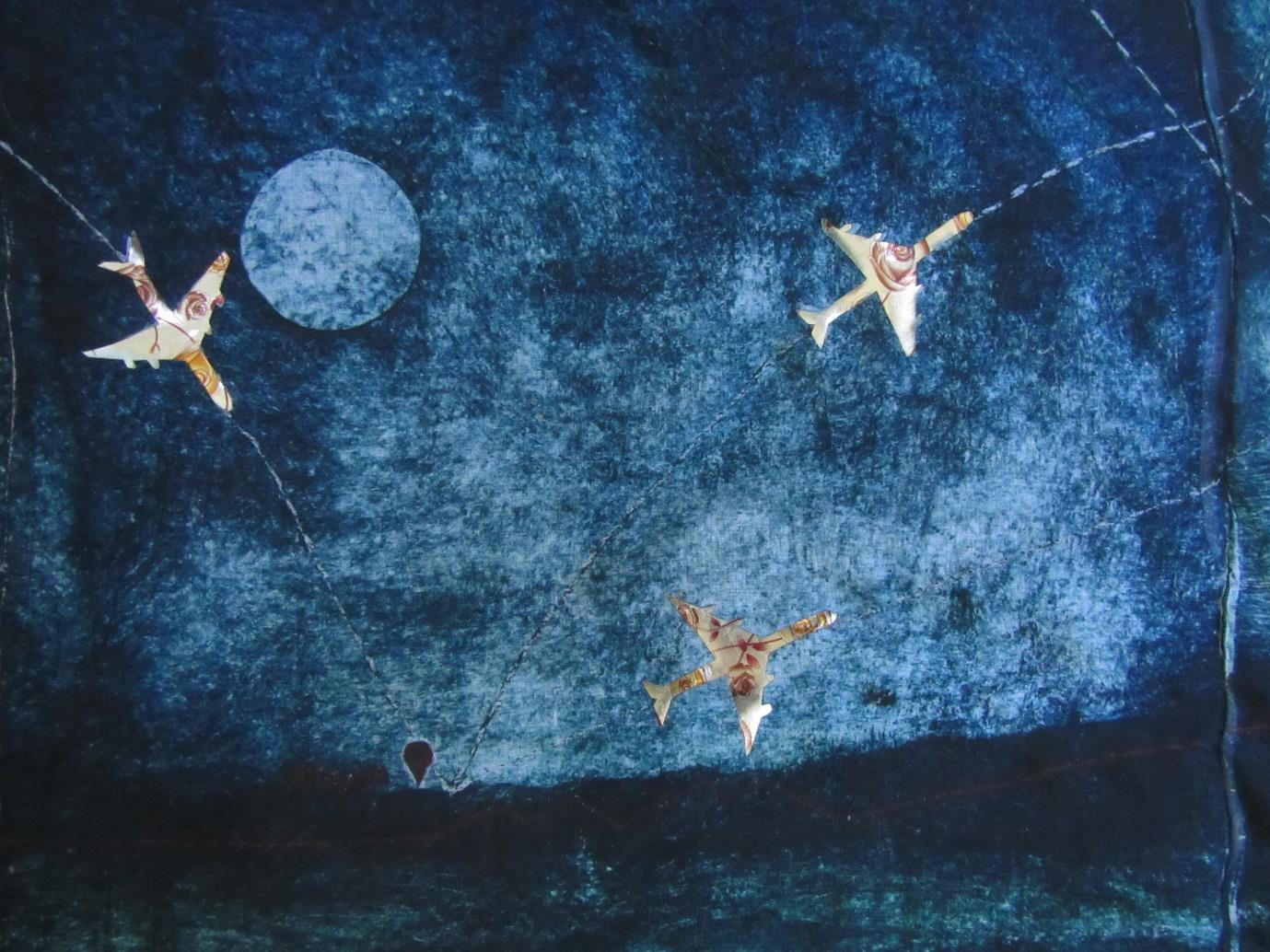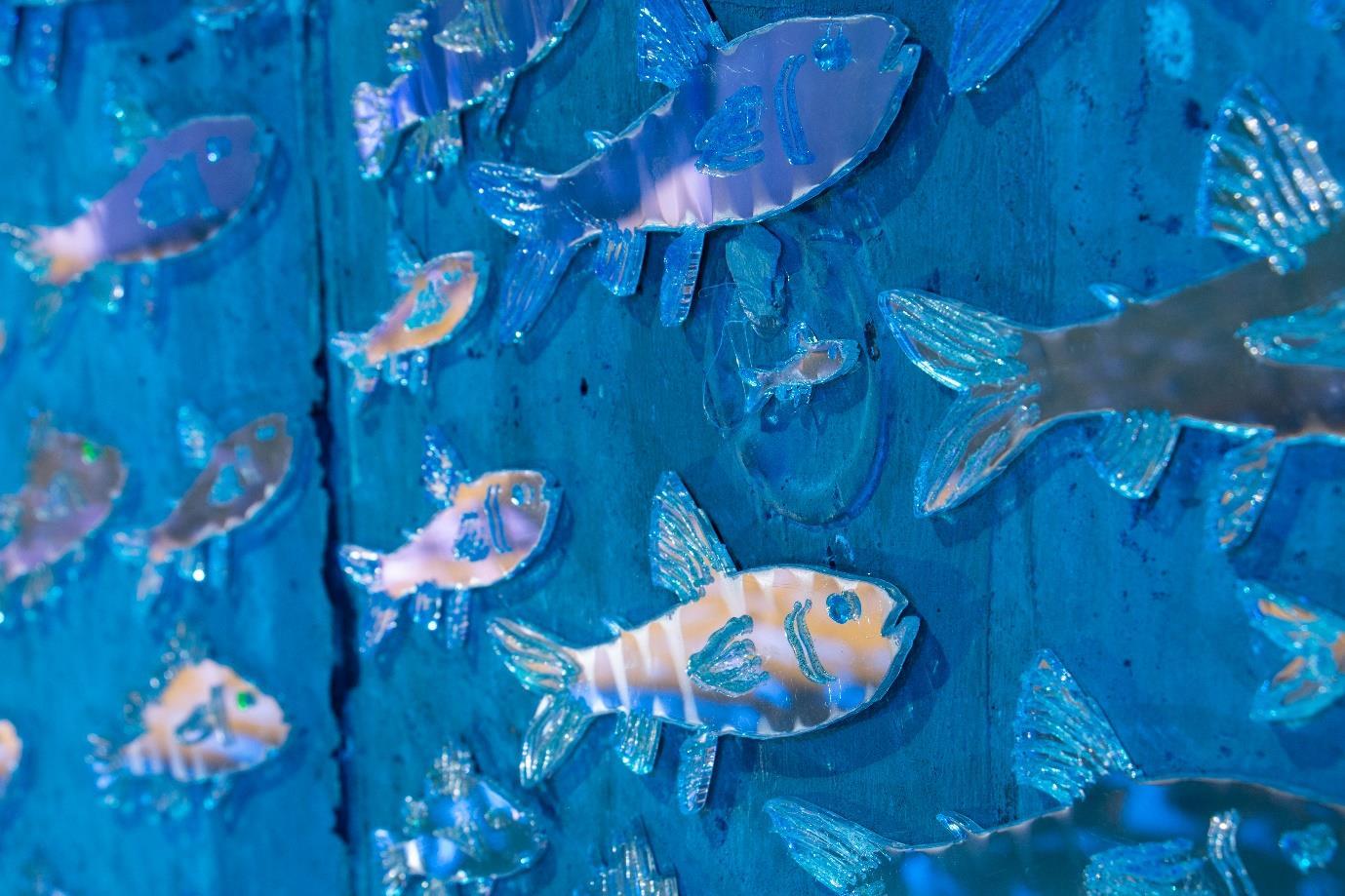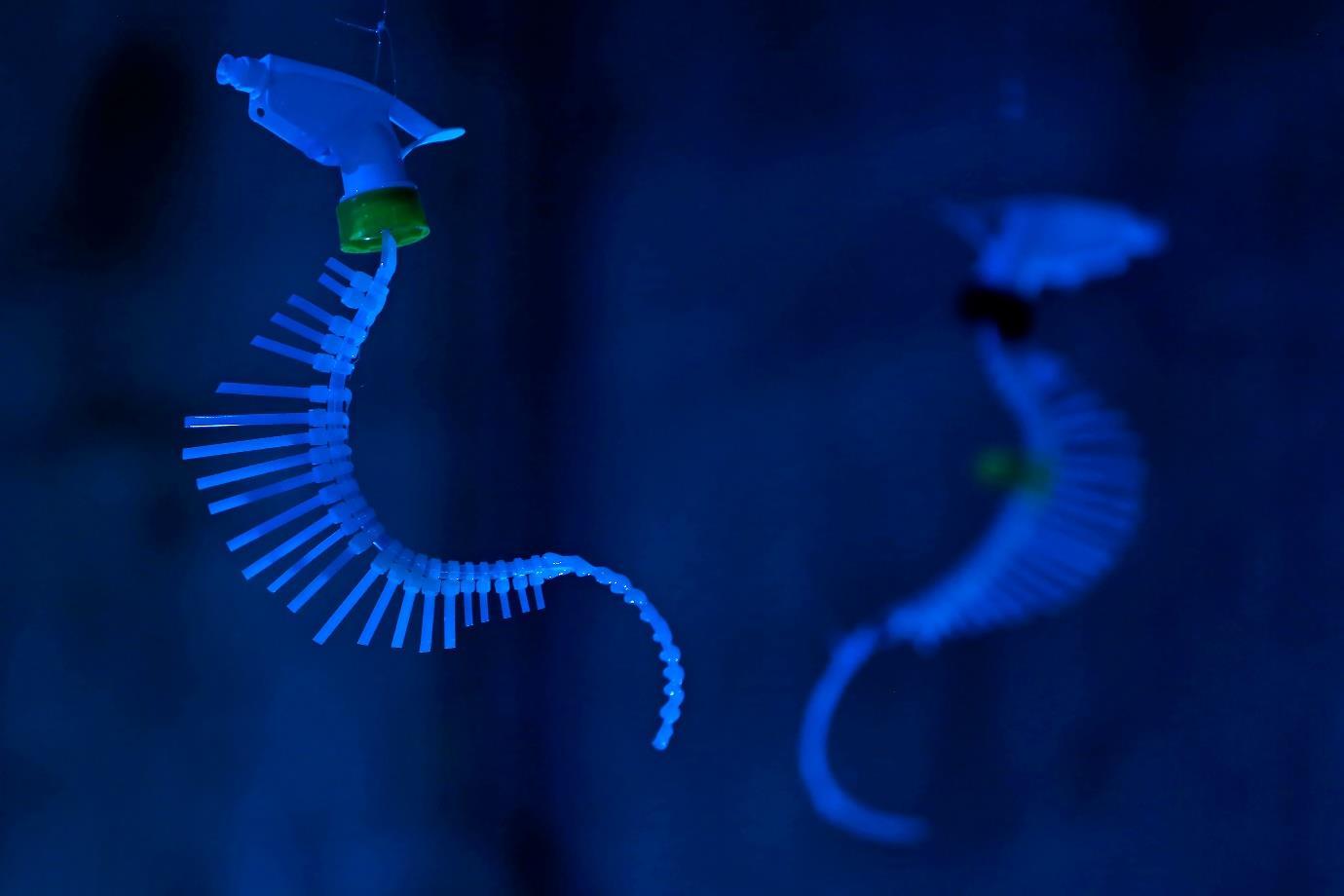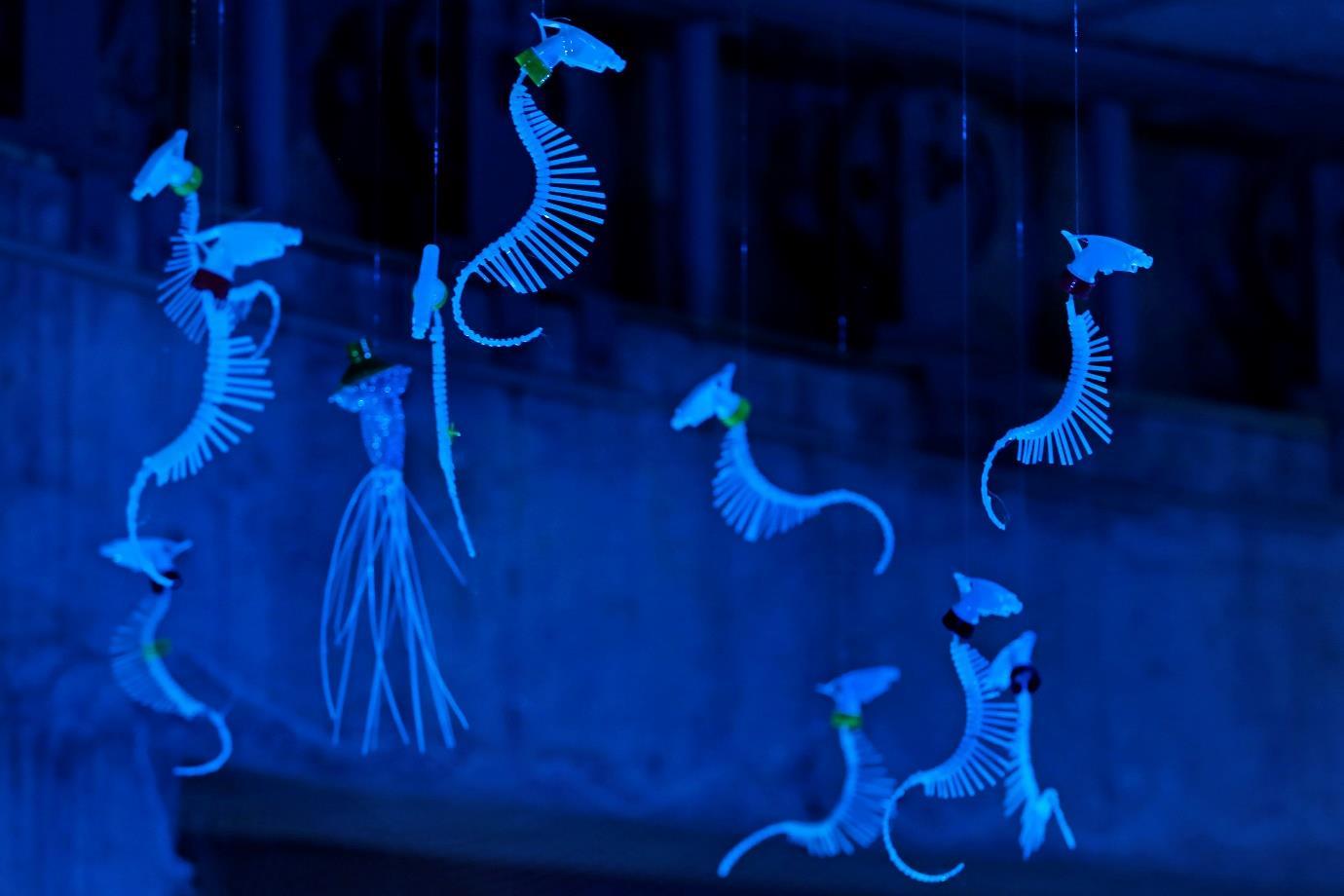The Abyssal Zone
An installation by Christine Dixie
The Abyssal Zone is a multi-media installation by Christine Dixie. It consists of sculpture, works on fabric ‘veils’ and a video with an original soundtrack. Four of the eight veils, entitled Echoes - Ghostprints for the Infanta were first exhibited at the Spier Light Art Festival in 2022. These works incorporate a text, Las Meninas, a text by Michel Foucault that in central to several other installations and exhibitions, To Be King 2014), The Santiago Cross: Invisible Trade (2015), Blueprint for the DisOrder of Things (2022) and Trade-Off (2024). As the first chapter to his book, The Order of Things, it deals with, (amongst other things) representation, power, and taxonomy.
The sea as a surface upon which ships sailed and which enabled Spanish trade and colonial expansion is represented in these previous works. In several of the series made for Blueprint for the DisOrder of Things I extended the spaces to represent what lay below the surface of the sea, incorporating fish and deep-sea divers into the works.
With The Abyssal Zone installation I dropped several depths below, evoking another sort of expansion and desire to acquire a different sort of power and wealth, one that is not on land but that lies on the ocean floor and is ironically tied to green energy.
The unfathomable depths and wondrous lives lived below the surface of the sea, the vastness of the galaxies and the equally unfathomable layers of the unconscious gravitated together in the blue-lit space of this installation which conjures up the liminal space of the night, dreams and hauntings
Abyss (n)
late 14c. in Latin form abyssus, "depths of the earth or sea; primordial chaos;" early 14c. as abime "depths of the earth or sea; bottomless pit, Hell". Both are from Late Latin abyssus "bottomless pit," from Greek abyssos (limnē) "bottomless (pool)," from abyssos "bottomless, unfathomed," hence, generally, "enormous, unfathomable," also as a noun, he abyssos "the great depth, the underworld, the bottomless pit."
The current form in English is a 16c. partial re-Latinization. Greek abyssos was used in Septuagint to translate Hebrew tehom "original chaos" and was used in the New Testament for "Hell." Old English glossed Latin abyssum with deagenesse, which is related to deagol "secret, hidden; dark, obscure."
The Abyssal Zone is dark, silent, and secret, inhabited by uncanny, luminous creatures which float above shifting sands. The sea floor gleams with gold, platinum, titanium, copper, cobalt, and manganese, minerals that are critical for batteries, solar panels, wind turbines, and electric vehicles.
In the 17th century, European ships floated across the ocean, enticed by lands of gold and the promise of fortunes. Stars guided the ships; elusive planets lit the dark surfaces.
If a ship had sunk, it might have come to rest on a seabed that held the very minerals it searched. This shadowy place is now threatened with the judder of collectors, the throbbing of tracked mining vehicles and pulsing bottom crawlers that spew toxic sediment plumes. Even the most remote, seemingly inaccessible parts of the planet are now threatened.
In the disrupted order depicted in this work, place and space are inverted. Fish, still glittering and beautiful are now inedible and swim alongside spacecraft. Our dreams are haunted by reverberations from the Abyss, perverse echoes of sky and sea, water and air, sustenance, and poison.
Echoes – Ghostprints for the Infanta
Four of the eight veils, entitled Echoes - Ghostprints for the Infanta were first exhibited at the Spier Light Art Festival in 2022. These works incorporate a text, Las Echoes – Ghostprints for the Infanta installation at the Spier Light Art Festival, 2023. They combine a form of printing called sublimation, spraypaint and details which have been sewn on. A fan blows through the space, moving the veils, evoking the sails of a ship.
Installation at the Spier Light Art Festival, 2023
In the aftermath of the pandemic, ‘ghosts’ haunt our landscapes, our world has wobbled on its axis and become unstable. In this illogical world transparent fish share the ocean with satellites and space probes, devices that have travelled across the dark realms of unknown galaxies.
Across vast arcs of time and space, ships from the past float across the surface. They are blown across a narrow band that is both sea and a bandage to dress a wound. These ghostly ships connect the twenty-first century to the seventeenth, between them lies our bodies, our faces, our eyes, doubly invisible.
In the night sky shimmering owls on the hunt fly across the pages of an open book. The text is from Michel Foucault’s chapter Las Meninas, the first chapter in his book The Order of Things. The words become part of the night sky through which the owl flies and over which the fish leap. Like the owls and bats that haunt our dreams in Goya’s The Sleep of Reason Produces Monsters, these creatures from the imagination defy reason as the natural order of things. The owl hovers for a moment, motionless, suspended, caught in a moment of stillness.
In the top panel constellations seen from the southern hemisphere connect star to star, the horse Pegasus beckons to leaping Pisces; a hunter, Orion, aims it arrow at a running dog, Canis Minor; and Leo, the lion constellation confronts the pincers of the crab, Cancer.
Between the sea and the sky, lie the open pages of a book, with words that reveal that in the midst of this dispersion spreading out before us is an essential void.
(The lines in bold are fragments from the text Las Meninas, used as a form of black out poetry).
The Abyssal Zone Video Projection
The veils became the starting point for a video projection that combines live footage and animation. The division of the screen into six sections mimics the idea of a middle section that is level with the human eye and space that is both above and below the human centered. The multiple divisions create images that combine, echo, mirror and juxtapose one another.
The soundtrack, developed by Corinne Cooper draws on the sounds of planets, machinery, and layers of synthesizer.
Credits for The Abyssal Zone video:
Melissa Parry editor
Samantha Munro animation
Corinne Cooper sound
The video projection was sponsored by Eco – Imagining.
Eco-Imagining works primarily in urban and peri-urban environments, exploring access to water, energy, and food on land in the context of climate change. Christine Dixie’s The Abyssal Zone places water, food, and energy resources in a wider perspective – on oceans as well as land. The ocean has always been a source of food, and for several hundred years, a means of distributing food, transport, and political domination. Oceans now also provide critical minerals for the technologies of clean energy. Christine Dixie exposes the ironies of plundering the ocean, polluting waters, and destroying marine life. In her works, astronauts inhabit deep waters; colonial and modern-day ships cross the skies, fish sail through celestial scapes. Having jeopardized the future on earth’s surfaces, we now disrupt planetary order. Work in Eco-Imagining in supported by the Dutch Research Council (NWO) and SA National Research Foundation (PI Moyer and Manderson).
Text by Lenore Manderson
Deep Sea Divers/Astronauts and Afronauts
During the National Arts Festival in Makhanda, 2024, another performance called Afronauts was taking place, a theatre production by Circus Zambia which was based on the story of Edward Mukaka, a Zambian schoolteacher in the 1960’s who attempted to train the first African crew to travel to the moon. I invited these acrobats to do a photo-shoot in the installation. Photographs of the Afronauts are by Jonathon Rees.
Machines above and below
The relationship between word and image is one of the threads that travels through the work that relates to the Las Meninas essay and painting. In The Abyssal Zone installation the relief sculptures of ships that hang from cables on the wall are made from keyboards in which the letters have been removed. Their function has shifted, the keyboards are no longer objects with which to communicate abstract text, they have become plastic objects which now convey meaning through their materiality and form. These plastic ships have pipes which ‘catch’ the schools of bejeweled fish that swim along the walls of the installation space.
In the images that appear on the ‘veils’, machines dominate the landscape both above and below the sea. In the sky aeroplanes take-off and land at port cities. On the ocean, transport and dredging vessels float as riser and return pipes below them delve from the Sunlight zone (Epipelagic zone) through the Twilight and Midnight zones and into the Abyss (Abyssopelagic zone). Far below on the Abyssal plains of the seafloor, ocean ridges echo the mountains above. Across this deep-sea mountain scape crawl collector, tracked mining vehicles and bottom crawlers. These machines can generate large sediment plumes, often laced with toxins and the reverberating sound impacts marine life. They are there to gather up gold, platinum, titanium, copper, cobalt, and manganese, ironically needed for many ‘green’ forms of energy including solar panels, wind turbines and electricvehicle batteries.
Sea life and spacecraft
The schools of fish, octopi, seahorses, sea anemone and squid that move through the space of the installation are all incarnated in some form of plastic as if a new form of life has developed as a result of absorbing micro-plastic particles. Schools of fish are joined by spacecraft, as if the depths of the ocean and deep space are no longer separated.






